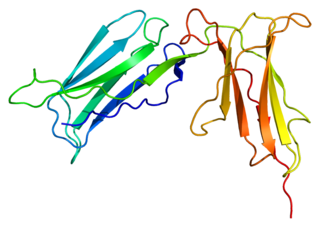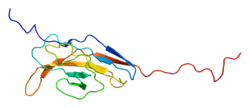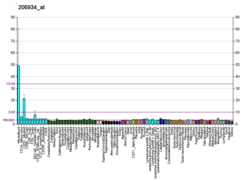
Chemokine ligand 20 (CCL20) or liver activation regulated chemokine (LARC) or Macrophage Inflammatory Protein-3 (MIP3A) is a small cytokine belonging to the CC chemokine family. It is strongly chemotactic for lymphocytes and weakly attracts neutrophils. CCL20 is implicated in the formation and function of mucosal lymphoid tissues via chemoattraction of lymphocytes and dendritic cells towards the epithelial cells surrounding these tissues. CCL20 elicits its effects on its target cells by binding and activating the chemokine receptor CCR6.

Chemokine ligand 19 (CCL19) is a protein that in humans is encoded by the CCL19 gene.

Interferon-alpha/beta receptor beta chain is a protein that in humans is encoded by the IFNAR2 gene.

Chemokine receptor 6 also known as CCR6 is a CC chemokine receptor protein which in humans is encoded by the CCR6 gene. CCR6 has also recently been designated CD196. The gene is located on the long arm of Chromosome 6 (6q27) on the Watson (plus) strand. It is 139,737 bases long and encodes a protein of 374 amino acids.

TYRO protein tyrosine kinase-binding protein is an adapter protein that in humans is encoded by the TYROBP gene.

C-C chemokine receptor type 10 is a protein that in humans is encoded by the CCR10 gene.

Chemokine-binding protein 2 is a protein that in humans is encoded by the CCBP2 gene.

Signal regulatory protein α (SIRPα) is a regulatory membrane glycoprotein from SIRP family expressed mainly by myeloid cells and also by stem cells or neurons.

CD244 also known as 2B4 or SLAMF4 is a protein that in humans is encoded by the CD244 gene.

Interleukin-12 receptor, beta 1, or IL-12Rβ1 in short, is a subunit of the interleukin 12 receptor and the interleukin 23 receptor. IL12RB1, is the name of its human gene. IL-12Rβ1 is also known as CD212.

Decoy receptor 3 (Dcr3), also known as tumor necrosis factor receptor superfamily member 6B (TNFRSF6B), TR6 and M68, is a soluble protein of the tumor necrosis factor receptor superfamily which inhibits Fas ligand-induced apoptosis.

Killer cell immunoglobulin-like receptor 3DL2 is a protein that in humans is encoded by the KIR3DL2 gene.

SLAM family member 6 is a protein that in humans is encoded by the SLAMF6 gene.

Interleukin 17 receptor A, also known as IL17RA and CDw217, is a human gene.

Killer cell immunoglobulin-like receptor 2DS4 is a protein that in humans is encoded by the KIR2DS4 gene.

Natural cytotoxicity triggering receptor 2 is a protein that in humans is encoded by the NCR2 gene. NCR2 has also been designated as CD336, NKp44, NKP44; NK-p44, LY95, and dJ149M18.1.

Hematopoietic cell signal transducer is a protein that in humans is encoded by the HCST gene.

Signal-regulatory protein gamma is a protein that in humans is encoded by the SIRPG gene. SIRPG has also recently been designated CD172G.

CD79b molecule, immunoglobulin-associated beta, also known as CD79B, is a human gene.

5-azacytidine-induced protein 2 is a protein that in humans is encoded by the AZI2 gene.






















